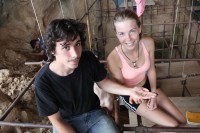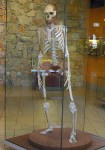 A French art history student has discovered an adult human tooth around 560,000 years old in the Arago Cave in Tautavel, southern France. It is one of the oldest human fossils ever found in Europe (the oldest is a 600,000-year-old jawbone found in Germany in 1907), and the oldest human body part ever found in France by 100,000 years. Its significance is bolstered by the scarcity of human remains in Europe from this period. There’s something of a gap in the record between 500,000 and 800,000 years ago and very little new material has been found. This one tooth is therefore of outsized importance.
A French art history student has discovered an adult human tooth around 560,000 years old in the Arago Cave in Tautavel, southern France. It is one of the oldest human fossils ever found in Europe (the oldest is a 600,000-year-old jawbone found in Germany in 1907), and the oldest human body part ever found in France by 100,000 years. Its significance is bolstered by the scarcity of human remains in Europe from this period. There’s something of a gap in the record between 500,000 and 800,000 years ago and very little new material has been found. This one tooth is therefore of outsized importance.
 Volunteer excavator Valentin Loescher, 20, one of more than 30 young people from France and around the world participating in this season’s excavation, discovered the tooth the afternoon of Thursday, July 23rd, in a section of the cave liberally sprinkled with animal remains. The volunteer digging next to him, Camille Jacquey, 16, was on a break when he found it. When she returned, they showed the find to Amélie Vialet, the paleoanthropologist leading the excavation team, who identified it as an adult human incisor from a lower jaw. Its age was determined by stratigraphic analysis; the layer in which the tooth was found has been dated with a variety of methods to confirm its range, so researchers are satisfied that the tooth is at least 550,000 years old, and maybe as much as 580,000 years old.
Volunteer excavator Valentin Loescher, 20, one of more than 30 young people from France and around the world participating in this season’s excavation, discovered the tooth the afternoon of Thursday, July 23rd, in a section of the cave liberally sprinkled with animal remains. The volunteer digging next to him, Camille Jacquey, 16, was on a break when he found it. When she returned, they showed the find to Amélie Vialet, the paleoanthropologist leading the excavation team, who identified it as an adult human incisor from a lower jaw. Its age was determined by stratigraphic analysis; the layer in which the tooth was found has been dated with a variety of methods to confirm its range, so researchers are satisfied that the tooth is at least 550,000 years old, and maybe as much as 580,000 years old.
Yves Coppens, professor of paleoanthropology and prehistory at the Collège de France, who was part of the 1970s team that discovered the remains of the famous early human ancestor known as Lucy in Ethiopia, told France Info radio: “A tooth can tell us a whole range of things. Its shape and wear and tear tells us about the eating habits of the person in question; the tissue reveals a lot of information. The DNA can give an idea as to who this person was.”
If there’s any tartar on the tooth, they might be able to do stable isotope analysis on it to determine the ancient person’s diet.
 There have been volunteers excavating the Arago Cave yearly since 1964. Thousands of people have given their time and dedication to the site for the past 50 years and they’ve been exceptionally productive. More than 600,000 prehistoric objects and remains have been unearthed since excavations began, most famously 140 bones and bone fragments from a single 450,000-year-old Homo erectus known as Tautavel Man. In a blissful historical coincidence, one of the volunteers in the 1979 excavation that unearthed a piece of Tautavel Man’s skull was Camille Jacquey’s mother.
There have been volunteers excavating the Arago Cave yearly since 1964. Thousands of people have given their time and dedication to the site for the past 50 years and they’ve been exceptionally productive. More than 600,000 prehistoric objects and remains have been unearthed since excavations began, most famously 140 bones and bone fragments from a single 450,000-year-old Homo erectus known as Tautavel Man. In a blissful historical coincidence, one of the volunteers in the 1979 excavation that unearthed a piece of Tautavel Man’s skull was Camille Jacquey’s mother.
 This season only began in May and the team has already made thousands of finds. Besides unearthing the tooth, the team has been able to determine what kind of pollen and vegetation were in the area, even the source of the flint knapped by the cave’s users (it’s a site about 20 miles away). They know the area was a treeless, arid steppe around the time the individual left the tooth in the cave, cold, snowy, windblown. Researchers hope the tooth may fill in some of the missing information about the people of who navigated this harsh landscape.
This season only began in May and the team has already made thousands of finds. Besides unearthing the tooth, the team has been able to determine what kind of pollen and vegetation were in the area, even the source of the flint knapped by the cave’s users (it’s a site about 20 miles away). They know the area was a treeless, arid steppe around the time the individual left the tooth in the cave, cold, snowy, windblown. Researchers hope the tooth may fill in some of the missing information about the people of who navigated this harsh landscape.
And they say art history majors never amount to anything!